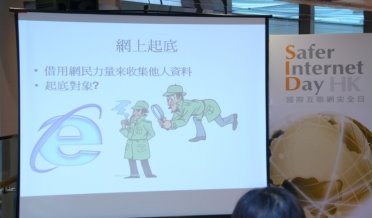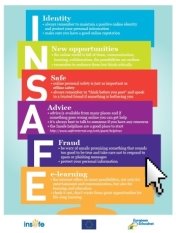Урок-диспут англійської мови в 10 класі, присвячений Міжнародному дню безпеки в Інтернеті
Internet safety permeates all aspects of online activity and is an entitlement for all children and young people. Research has demonstrated that the most effective online safety measures include parents, teachers and young people all working together. The theme for Safer Internet Day 2017, 'Connecting Generations' where we encourage users young and old to 'discover the digital world together...safely!' provides an ideal opportunity to engage parents, carers and other family members with online safety issues.
Урок-диспут
англійської мови в 10 класі, присвячений
Міжнародному дню безпеки в Інтернеті
вчитель: Железковська О.Ю.
КЗ «Олександрівське НВО №1»,
Олександрівська
загальноосвітня школа І-ІІІ ступенів №1

Safer Internet Day 2017
Lesson plan:
Lesson title: Connecting generations
School subject: Cross-curricular (English and ICT)
Allocated time: 90 minutes
Pupils’ age: 8 - 14
Description of the issue: Internet safety permeates all aspects of online activity and is an entitlement for all children and young people. Research has demonstrated that the most effective online safety measures include parents, teachers and young people all working together. The theme for Safer Internet Day 2017, ‘Connecting Generations’ where we encourage users young and old to ‘discover the digital world together...safely!’ provides an ideal opportunity to engage parents, carers and other family members with online safety issues.
Objective for teachers:
• To enhance pupils’ understanding of the importance of safety and security on the internet.
• To provide opportunities for pupils to work with their parents and wider family members on online safety issues.
Objectives for pupils:
• To explain the importance of online safety.
• To identify strategies for staying safe online.
• To talk to their parents and carers about how they use the internet and mobile devices using a leaflet or brochure to support.
Skills developed: Integrated language, design and ICT skills.
Assumed knowledge:
• Pupils are familiar with the basics of PowerPoint or a similar application and have a good command of English.
• Teachers will need to have some understanding of the key online safety issues that would need to be communicated with parents or other children.
Equipment needed: Computers with an internet connection and a video projector, cardboard, pens, pencils, existing online safety resources for children and parents.
Safer Internet Day 2017:
Lesson plan – Connecting generations
Stages and activities
Time
Introduction
• Greetings. 3 minutes
T: Watch the video and tell what are we going to speak about?
• Explain that today the pupils will be starting work on producing a leaflet/presentation to teach their parents about internet safety.

Initial discussion and explanation of task
• Start a discussion about the internet – some of the following questions could be useful as starters: 10 minutes
1. Who uses the internet?
2. What do you do on the internet? What is good about it?
Spend some time allowing the pupils to talk about what they do online or with their mobile phone: they should be keen to talk about this, but questions about online games, social networking or favourite websites are always good prompts.
• If no one has mentioned any of the potential risks of going online, introduce this concept. It is important to emphasise that the risks that can be associated with the internet are also associated with the offline world. For example, bullying is something that has always existed, but now schools have to deal with online bullying – the issues are the same. 5 minutes
• Ask the pupils how their parents use technology? Are they confident? Do they know a lot about the internet and computing? (Research from EU Kids Online found that 53 per cent of parents felt that they should do more about online safety and 15 per cent of children who would like their parents to take more interest in what they are doing online.)
• Explain that the pupils are going to be working in small groups (4) to design a short leaflet/presentation to help their parents to understand more about online safety. Tell them that the leaflet/presentation has to incorporate the following:
5 minutes
1. It must be attractive and engaging for the reader/audience (a presentation will need to have an accompanying script or notes for the presenter).
2. It has to give a balanced view of online safety, the risks and the benefits.
3. It has to include some top tips for parents.
4. It has to provide references to other websites and resources that parents would find useful.
Suggest that they might like to divide the tasks up (these could include research, design, editing).
Tell pupils that one of the leaflets/presentations will be published and distributed/shown to all parents as part of the school’s Safer Internet Day celebrations.
• Ask the pupils if they have any questions.
Independent work 20 minutes
• Set the pupils off to work in their groups with a deadline of 20 minutes after which time they need to have decided on the basic design of their leaflet/presentation and the key issues that they will focus on.
Provide them with some examples of existing resources for parents.
Mini-plenary 5 minutes
• Briefly discuss with the groups how they have managed the tasks so far – were there any difficulties, do any points need clarification?
• Share some of the outcomes from one or two groups.
Independent work - producing the leaflet/presentation 30 minutes
• It may not be possible for the pupils to finish the leaflet/presentation during this session but set out expectations for a minimum that needs to be done.
The Conclusion of the Lesson
- Summarising
Evaluation 10 minutes
T: For your participation in activities making the theme of Connecting generation and educating each other you will get this certificate.
This website aims to showcase the many exciting activities and events that will be taking part across the globe to celebrate the day. Click on the map below to get started, using the zoom control to locate events in your country. Alternatively, visit the 'SID Near You' section to explore news from the many countries and institutions that will be taking part.
If you have ideas for SID 2017, or would like to organise a SID activity in your  own country, we'd love to hear from you. Contact us at sid-helpdesk@eun.org.
own country, we'd love to hear from you. Contact us at sid-helpdesk@eun.org.
Safer Internet Day 2017 –
Lesson plan:
SID video spot: discussion and extension activities
Access the SID 2012 video spot at:
www.saferinternetday.org/sidkit2017
Each year, as part of the Safer Internet Day (SID) campaign, we produce a short video spot to raise awareness of the theme in a fun and amusing way. This year’s video shows how new technologies can help to connect generations, encouraging users both young and old to join together in creating positive online experiences, to share knowledge and wisdom, but also to support each other when things might be risky or, indeed, go wrong.
These activities could also be used as a starting point for entering the Safer Internet Day poster and video competition – find out more at www.saferinternetday.org/SIDcompetitions.
Background information
The internet mirrors real life, and for children and young people there is little or no distinction between the online and offline worlds. On Safer Internet Day there is a real opportunity to encourage dialogue between children and their parents/grandparents/family and pupils and teachers and the video and accompanying notes for guidance seek to provide ways to stimulate debate and discussion.
Pupils up to the age of 13
Learning objectives
• To establish a basis for dialogue between children and their parents and pupils and their teachers.
• To encourage children and young people to ask for help if there is something that concerns them when they are online.
• To improve children and young peoples’ understanding of how to stay safe online.
Activity
Have an open discussion with pupils and begin by encouraging them to say what they think is good about the internet.
Pupils up to the age of 11
Ask them to speak to a talk partner (or the person sitting next to them): hopefully they will respond with things like watching videos, playing games, research, downloading music, buying and selling things etc. Give them plenty of opportunities to talk about all of the positives.
Ask whether there are things which are not quite so good about the internet. Emphasise that the internet mirrors real life and as such there is good and bad. It is important to point out to them that the internet is not bad, it is the way that it is used by individuals that is either good or bad.
What should they do if something upsets or bothers them when they are online? For pupils of this age, the important message has to be that they should talk to a trusted adult.
Giving pupils the opportunity to talk about some of the positive and negative issues around the internet should open up plenty of discussion and debate. Some sensitivity is needed with younger pupils around the use of social networking sites such as Facebook where pupils should be 13 or older. It is widely known that there are many younger children using these sites, but the school should consider how they will approach these issues should they arise.
Pupils aged between 11 and 13
As above, but rather than use talk partners, ask the pupils to work in small groups and nominate one person to provide feedback on what was discussed. Also ask pupils to suggest ways to guard against some of the negative issues that they came up with.
Using the SID video spot
Following the discussions, tell pupils you are going to show them a short video and then ask them some questions after they have watched it.
Play the video and ask the pupils what they think the message is that the video is trying to convey. Explain that we all have things to learn about the internet and how to stay safe on there.
• What do the pupils think are the most important messages?
Safer Internet Day 2017:
Lesson plan – SID video spot
• How can they help their parents, grandparents and other family members to stay safe?
• Do they think that there are things they can learn from these people?
With each age group of pupils ask them to come up with three key messages for staying safe online.
Possible extension activity
Design a poster or screensaver to remind others about how to stay safe online – using the three key messages.
Safer Internet Day 2017:
Lesson plan – SID video spot
Pupils over the age of 13
Learning objectives
• To identify the risks and benefits of using the internet and online communication.
• To develop a resource to communicate these messages to a given audience.
• To increase their own understanding of how to stay safe online.
Activity
Ask pupils to think about the positive aspects of the internet and online communication. Depending on the size of the group it may be possible to also ask them to share some of their thoughts on this. Explain that internet safety messages can be difficult to communicate to pupils and ask them what they think the greatest risks/issues are facing children and young people today when they go online.
Once these issues have been established, ask the pupils to come up with a way to deliver these messages in a way that will engage the audience effectively. What would be the key components of an effective awareness campaign? What would be the main aim?
Some questions to consider
• Do pupils think that adults (parents, teachers, others) have a role to play in online safety? What can they learn from these groups of people?
• Do young people need information about how to stay safe online? If so, where should this come from and in what form should it be?
• Is the current provision working?
• What needs to be changed?
Using the SID video spot
Following the discussions, tell pupils you are going to show them a short video.
Play the video and ask the pupils what they think the message is that the video is trying to convey. Point out that everyone, regardless of age has things to learn about using the internet and how to stay safe on there.
• Ask pupils to comment on the video and the messages it is trying to convey. Which age group is most likely to respond to the video?
• Ask them to begin to think about how they could use video in order to raise awareness of an online safety issue to a given audience.
• Give pupils time to start to plan their own video resource to raise awareness and if possible provide opportunities for them to create a short spot themselves.
Possible extension activities
• Ask pupils to design a short guide to explain how to set up a Facebook profile paying particular attention to safety and privacy.
• Ask pupils to produce a short, hard-hitting video to highlight an online safety issue and suggest some simple solutions that will help other users to stay safe online.
• Work in a small group to produce a leaflet or poster aimed at raising awareness of a particular online issue – discuss the target group, focus etc.
1


про публікацію авторської розробки
Додати розробку
